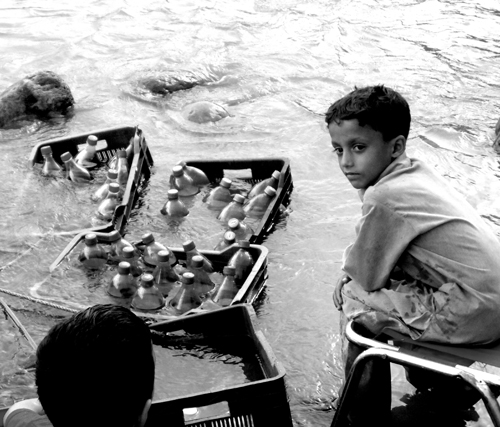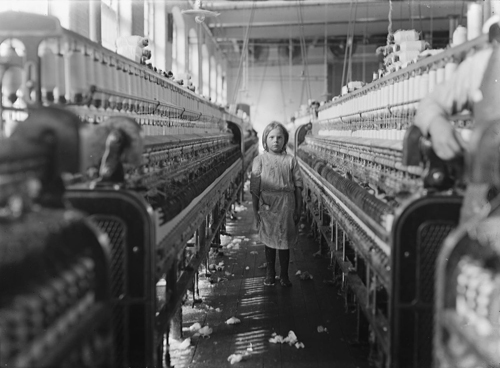
Your complimentary articles
You’ve read one of your four complimentary articles for this month.
You can read four articles free per month. To have complete access to the thousands of philosophy articles on this site, please
Art & Philosophy
The Not So Benign World of Photography
Atika Qasim questions her own, and others’, motives for taking photos.

This picture was taken in the summer of 2010. My family had decided to head over to the northern mountains of Pakistan to spend our vacations. The boy in the picture sits next to the Kunhar River in the small town of Balakot, a few miles from our destination, Naran. Being only a little girl back then, I didn’t quite know how to operate a camera, and the picture was never intended to take the form we see here. I had been trying to capture the bottles being kept cold in the river, and the boy just happened to be beside them. He had been a mere obstruction then, and it was only a few years later that I realised how captivating the scene was. I meant to submit it for an art exhibition in my high school, but it never happened. But having berated myself for not doing so out of laziness, I now sigh in relief. My motives in turning this boy into a work of art were based in seeking praise for a skill I never had – photography. With no empathetic attachment towards him, no knowledge of his story and identity, I was going to write a story for him: one that was to be his, but not from him. In this article, I want, to look briefly at how artists often overwrite the narratives and voices of their subjects to suit their own interests, and how, in doing so, they reduce conscious beings down to the mere objects of their attention.
When I first found this picture in my camera, I felt a certain sense of pull towards the boy – a pity that I had masked to myself as empathy, in order to make a case for bringing an ‘under-privileged village boy’ in front of the privileged ‘givers’ of my peers. The absurdity of this only began to become clear to me once I read Frantz Fanon’s Black Skin, White Mask (1952). In this book Fanon talks about power dynamics and subjugation from a racial/anti-colonial perspective. Inspired by Qalandar Memon's reading of Fanon in the book, Curating After the Global: Roadmaps for the Future (2019), I want to take this analysis a little further.
In the introduction to the book, Fanon distinguishes between zones of nonbeing and being. The ‘zone of nonbeing’, as he puts it, is ‘sterile and arid’ – a region of desperation, lack and suffering, essentially inhabited by the subaltern of the world – or for the sake of this article, the subaltern of Lahore, where I live. (‘Subaltern’ is a fancier, more ‘academically appropriate’ word for the marginalised.) On the other hand, the ‘zone of being’ is one of privilege and power – a region I happen to inhabit. Just as in a colonial situation, where white men possess the power to define their coloured subjects, so it is true for their privileged ‘inheritors’ in this post-colony: the rich of Lahore get to define and determine the stories of the poor, while the poor themselves have little or no power in or over the process of being defined. But I was going to do just that sort of privileged defining by handing in this picture for the exhibition.
The boy had been selling cold drinks to tourists. He couldn’t afford a fridge, perhaps, or maybe he had been sustainable before it was cool. Someone from a privileged background might wonder why a boy his age was not in school. So many thoughts could be conjured up on his behalf. But if only we could gather up the decency of actually asking him about his life, we wouldn’t have to do the defining on his behalf.
The defining mind-set is based somewhere in the idea that, as inhabitants of the ‘zone of being’, we possess the power to change the world, and therefore it’s a moral responsibility on our behalf to look after (and unfortunately, look over) those who cannot look after themselves. We assume that since the subaltern cannot speak, we must do so on their behalf. Reality, however, is very different. The marginalised have been speaking – or rather screaming – all the while: it’s just that we choose not to listen to their voices. What then appears to us as ‘voiceless flailing’ is a cry for help – so we must then jump in to save them.
This ‘moral duty’ now appears to me as all too performative. I call it ‘paternalistic benevolence’: you first define these people, then try to undefine, before redefining them to suit your agenda. Paulo Freire explains this phenomenon better in his book The Pedagogy of the Oppressed (tr. 2005), when he says, “In order to have the continued opportunity to express their ‘generosity’, the oppressors must perpetuate injustice as well. An unjust social order is the permanent fount of this ‘generosity’.”
This process allows us to redeem ourselves. Like holy water, this ‘generosity’ is a way of trying to wash away our guilt at being privileged. But I want to relate this idea to the art world more specifically, because here the paternalism of the inhabitants of the ‘zone of being’ is heavily disguised as benign. Here the process of overwriting narratives – of defining subjects, and reducing them down to ornaments for our art galleries – is done so beautifully that it appears almost altruistic.
In her paper, ‘Glued to the image: A critical phenomenology of racialisation through works of art’ (2019), Alia Al-Saji talks about this process of overwriting narratives and how they’re constantly reinforced via art. She takes Fanon’s ideas and builds an argument around them and around themes of orientalism in works of art. She argues that racism (which can be widely understood as an ‘othering’) relies on ‘an epistemology of ignorance’. Al-Saji outlines how the white man is usually well aware of the racial situation, but at the same time pretends not to be. The narratives then produced are a product of their deliberate ignorance towards the lives of others – be they the people of colour for Fanon and Saji, or the subaltern of Lahore for me.
This dynamic becomes even more absurd when seen from here in Lahore. Here, those in the zone of nonbeing are systematically kept away from the world of art. First, art is a luxury for them, and is therefore inaccessible and so worthless to them. Inhabitants of this zone do not have the time to indulge in ‘art’, or they’ll lose precious wages. Art is only useful if it can be used to buy bread: for example, as painters in construction work, truck artists, or calligraphers for political banners. And these are mostly considered as side jobs by workers.
In Lahore (as in much of the world), the artists who make it into the galleries belong mostly to the urban middle- to upper- classes. Those who own and curate these galleries also happen to be the same class of people, if not richer. Their art mostly focuses on themes which interest them, their donors, and the foreign guests who visit once in a while. One of the famous themes for this world, is to look upon the world of nonbeing and bring light upon it for ‘charitable’ purposes. Here, subjects are depicted in a constant need of help and ‘benevolence’. Their body-language is often depicted such that they are shown as weak and undesirable. Not only are their situations made to look undesirable, but also the subjects’ bodies: their faces, their skin, and so on. The picture becomes an ibrat for the rich – an Urdu word which means ‘warning’ or ‘lesson’. They provide cautionary tales for the comfortable. Just as the ‘phallocentric Western gaze’ of white artists reduces ‘exotic’ non-Western women down to sexual objects, the denizens of the ‘zone of nonbeing’ are reduced down to objects for the rich and ‘benevolent’ gaze. This gaze looks only at the posed picture it has created, and not at the reality. And no matter how generous or kind this gaze may actually be, it’ll always look down on the people in the ‘zone of non-being’.

Child Labor in the Carolinas, Lewis Hines, 1909 (also overleaf)
It is especially unsettling that the subjects of such art are not only deprived of their voices and identities, but in practice physically barred from these ‘open-to-all’ art galleries which display their likenesses. In Gulberg, an area for the ultra-rich of Lahore, are a couple art galleries I’ve visited over the years here as a student. In theory they’re open to everyone; but in reality you’ll never find anyone in rags, any woman holding ethnic pots, or any child, except for the ones framed on the walls. The armed guards outside these buildings ensure that any dangerous and strange person isn’t allowed in. (The words ‘strange’ and ‘dangerous’ are always understood together about those in the ‘zone of nonbeing’.) This makes the entire ordeal somewhat ironic: the subjects are too strange to be let into these spaces in person, but are a source of both inspiration and pity when represented as art in these spaces!
What should one say about all this? One might argue that artists too possess freedom of expression, and that their work is a representation of their own perspective. This may be true – but that doesn’t excuse reduction of the underprivileged to ornaments and caricatures, for the sake of one’s own freedom. There have been artists in the past, and even today, who rather than impose their own perspective, only amplify the voices of their subjects themselves. Lewis Hine, a twentieth century American photographer who used his work to draw attention to social ills, is one such artist. Although Hine was from the ‘zone of being’, he didn’t reduce these people to ornaments for the drawing rooms of the rich. Rather, he took his work to the conference rooms of the decision-makers and compelled them to take action. His work, Child Labour in the Carolinas (1909), sympathetically portrayed the problem of child labour and proved that art could be a force of substantial social reform.

Like Hine, one can be sensitive in one’s art, especially when representing someone else. Be kind enough to listen to them and let them define themselves. Then write their stories: ones they have narrated. And after doing so, let these people into the art galleries; and not just in the form of hanging them on the walls. Make the space of art inclusive, from creation to depiction. This process can only be achieved with participation on equal levels from those in the zones of being and nonbeing. Otherwise, depiction will remain an act of paternalistic benevolence.
I took this picture ten years ago, but now I would never dare do the speaking on this boy’s behalf. I acknowledge him as more than an object of my gaze. Although I do wonder sometimes if he still sells cold drinks by the Kunhar River, or if fate led him onto another path.
© Atika Qasim 2021
Atika Qasim is a Political Science graduate, currently living in Pakistan.









